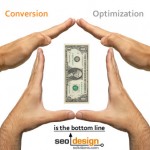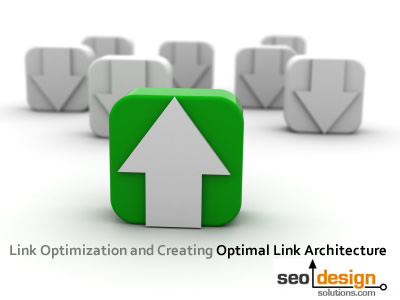The value of creating optimal internal link architecture to define your preferred destination/landing pages to search engines is priceless for SEO.
How you link to yourself from page to page matters, things such as the frequency of links, the total volume of links from which pages (strong, mediocre or barely indexed) and the proximity of the link (contextual links higher up in the body of the page, stand alone or footer link) all play a role in the destination pages buoyancy and what percentage of authority and ranking factor it can amass.
Even though it may seem of little consequence now, later as your site ages and gains trust (over the years), those links are magnified exponentially and can be some of your websites strongest links (even stronger and more relevant than targeted one way links from other sites).
I was providing an SEO consultation to one of our newer clients who are the proud owner of an aged authority / hub site. The site in question has well over 70K unique visitors (on a slow month) replete with internal page rank on multiple pages with both deep relevant deep links from other authority sites and an array of stemmed rankings from hundreds of pages. The site has been online for over 12 years and seen traffic well into the hundreds of thousands of unique visitors per month, but has now taken a dip; the solution, time to look under the hood at basic SEO metrics.
This is a site with a tremendous amount of trust and authority in a very competitive space which already ranks for keywords that most could only dream of accomplishing with a team of SEO’s and a 5 year head start. The main distinction here is this site “IS” an authority site, not one in the making, so the rules that govern them are more akin to favoring granular changes and rewarding them with big movements in the SERPs (search engine result pages).
When you work on robust websites with thousands of pages, you start to realize that the rules that govern smaller sites who have to scratch, bite and claw their way to the top compared to an aged site that created content years ago and let it simmer and develop authority. An entire array of things can be done with a site such as this compared to a newer site that has not gained that degree of regard from search engines.
Thinking from the perspective of potential vs. latent ranking power, potential is what a site has “IF” you do the right things (in chronology) and all of them work in your favor to produce domain authority. On the other hand, latent ranking factors exist within any site after it has reached a certain degree of exposure, indexing and fusion. The site with latent ranking potential can jump from not in the top 1000 results for a related keyword to hitting the top 10 in 30 days with minimal effort whereas a newer site with less impact may take 3-6 months to pass other sites such as this on the way up.
There is always a plateau and that keyword based theme / plateau is a moving target. You can never rest on your laurels completely, regardless of any search engine position, because in a moment’s notice or through a swift upgrade to a dated algorithm, what you knew could disappear. The rules of engagement change, depending on your strategic position, in this instance a website with authority and traffic baked in has more to lose from losing sight of SEO basics, more so than any other type of website at any other stage.
Prior to search engines, sites of this nature had already exceeded definition despite the facets of peer review that now make search engine rankings a matter of citation and popularity. Since trust is often grandfathered into sites of this nature, when you finally do apply modern optimization/SEO tactics, the results are nothing less than phenomenal.
The takeaway here is, what are you telling search engines by the way that you link to yourself? This site clearly underestimated the value of internal anchor text preference. In a worst case scenario you have adobe (who still ranks in the top 3 for “click here”) who suffers from off page anchor text referencing enough times with the same continuity, that search engines reward the ranking (thanks to other websites linking to Adobe with anchor text “click here to download adobe acrobat”).
Although hyper-linking/anchor text from one page to the next seems like such a mindless task, who would have thought that over time that those choices could sway the ultimate destiny or threshold of just how high that page would climb on its own merit when the links because seasoned and the definitions stuck?
The fact of the matter is, links in addition to content “ARE” the very fabric of the web, and you need them to navigate from one page to the next. In reality, their naming convention or how accurately they represent where they link to is the responsibility of the webmaster to ensure that relevant anchor text (the text in the link or the alt attribute of an image / link) clearly identifies what visitors and spiders alike should expect to find if they click that link.
If what you tell search engines matches with their weighting algorithm and how they deem content relevant as well as the off page factors mirror that continuity (others link to you in the same way you link to yourself) the destination page can gain a tremendous amount of buoyant ranking factor (meaning it will naturally rise to the top for any related keyword or key phrase deeply rooted in the context of the content on that page).
What Are You Telling Search Engines Based On the Way You Link?
1) If you still have multiple anchors (in link or image form) to a page from another page in your website, then all you need is one to solidify intent or pass ranking factor. If you have multiple, then use the rel=”nofollow” attribute in the hyperlink to dampen the affect of cannibalizing your internal link optimization. Some call it “first link priority”, however, for most SEO’s, it is just common sense.
2) If you still have long strings of words linked as a hyperlink to another page, try to limit the anchor to 3-4 words to pass the most value for that shingle (group of words). The days of entire paragraphs being considered relevant as a ranking factor have come and gone. Less is more, specifically with links and determining the best page and the best location (based on prominence) is ideal to pass the most link weight and flow to the destination page.
3) Realize that the links of today sculpt the SEO of tomorrow (both internal links and external links). So, if you want to elevate a page in your website in search engines, search engines are still going to ask you first, what do you say that page is? The way you communicate that is (a) ensuring that you use the most relevant and succinct anchor text that best represents the destination page (for every link in your website) and (b) do so in volume from other relevant pages.
Now in the instance of this consultation and based on the fact that they linked from the homepage using a resourceful tactic to provide guidance to their visitors and as a result that rank #1 for many terms that do not best describe their business model, they now rank for every one of those groups of words in the links.
Would this have happened to a lesser site, probably not, but when you have 7000 plus pages of content linking back to your homepage from the navigation all with prominent ranking factor attached, you need to be careful where you point links from the homepage.
All of this can be easily corrected from a simple on page link audit and link optimization, but it is better to do it right the first time around than going back to clean up the mess after it has aged and consolidated itself as the trunk supplying all of the link flow to the rest of such an enormous site.
With links, be careful where you point them, but more importantly, realize that when they mature (6 months, 1 year, 3 years, 5 years or more) they are a real force to contend with to drive your content straight to the top. Be mindful now, so you won’t have to hire someone later to ensure optimal internal link architecture.












good post now i know the important of link building
This was the missing link for me regarding how to establishing our interal linking…thank YOU!!!!